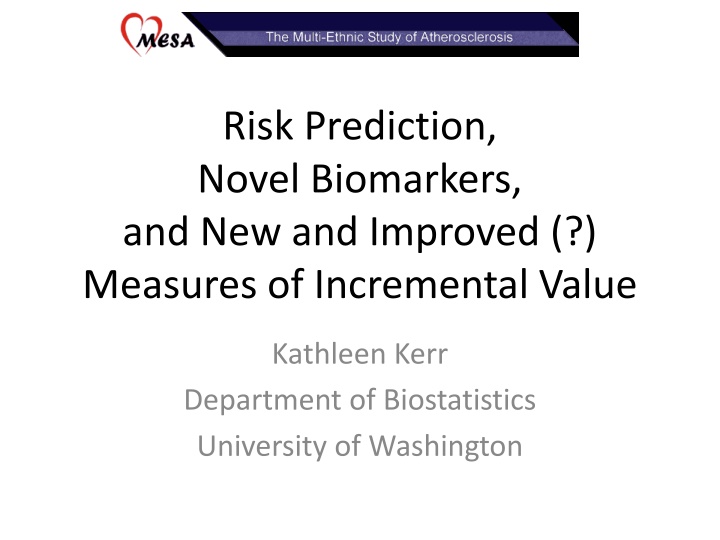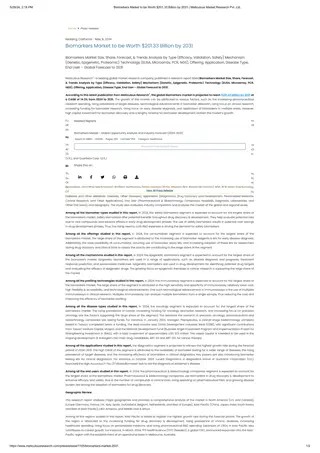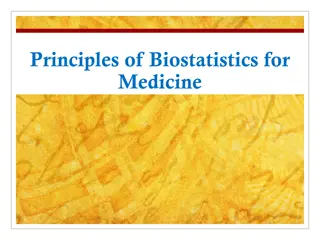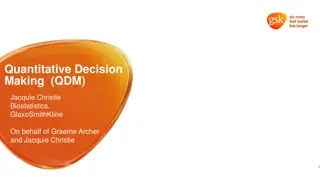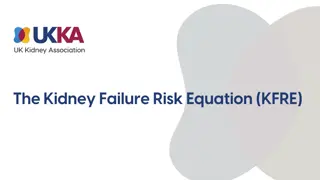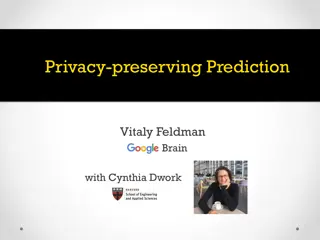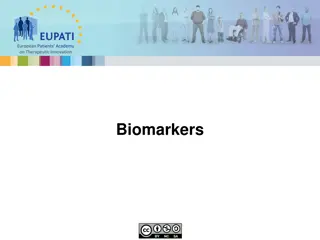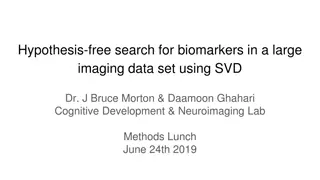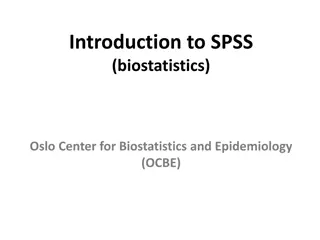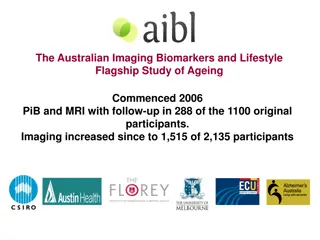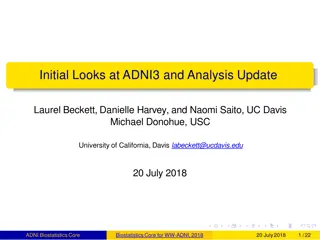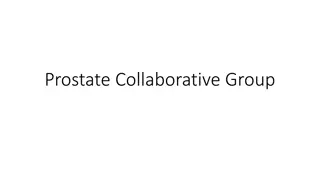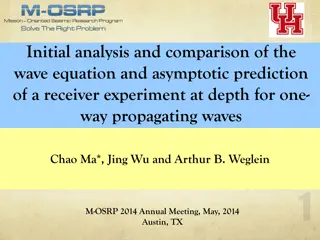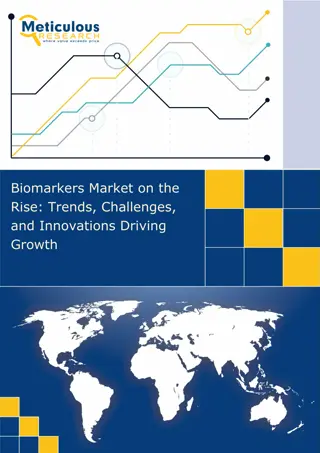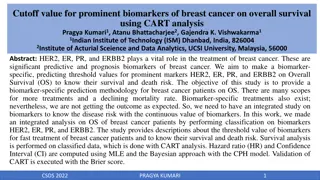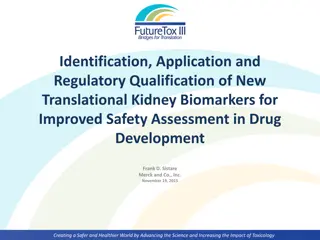Risk Prediction and Novel Biomarkers in Biostatistics
A study by Kathleen Kerr from the University of Washington on risk prediction, novel biomarkers, and measures of incremental value in biostatistics. The research delves into improving risk assessment methodologies and identifying new markers that contribute to better predictive models. Kerr's work aims to enhance the understanding of factors influencing disease susceptibility and progression, ultimately leading to advancements in early detection and personalized treatment strategies.
Download Presentation

Please find below an Image/Link to download the presentation.
The content on the website is provided AS IS for your information and personal use only. It may not be sold, licensed, or shared on other websites without obtaining consent from the author.If you encounter any issues during the download, it is possible that the publisher has removed the file from their server.
You are allowed to download the files provided on this website for personal or commercial use, subject to the condition that they are used lawfully. All files are the property of their respective owners.
The content on the website is provided AS IS for your information and personal use only. It may not be sold, licensed, or shared on other websites without obtaining consent from the author.
E N D
Presentation Transcript
Risk Prediction, Novel Biomarkers, and New and Improved (?) Measures of Incremental Value Kathleen Kerr Department of Biostatistics University of Washington
Outline Evaluating the Incremental Value of a Biomarker The Integrated Discrimination Improvement (IDI) Index Net Reclassification Indices (NRI) Historical context
MESA example: Polonsky et al, JAMA 2010 Considered Coronary Artery Calcium Score (CACS) as a biomarker in addition to Framingham risk factors to predict risk for CHD events.
New Biomarkers Incremental Value: the improvement in prediction from using a new marker in addition to existing markers. Kattan (2008): Markers should be judged on their ability to improve an already optimized prediction model. How exactly does one implement this?
A two-stage approach Use a regression model to estimate P(D| X, Y ) where X is the established predictor(s) and Y is the new marker e.g., logit P(D=1|X,Y)= 0+ 1X+ 2Y Test H0: 2=0 If the null hypothesis is rejected, then examine AUCX,Y( ) and test H0: AUCX,Y( ) = AUCX( )
Empirical argument against the two-stage approach: Theoretical argument: 6
Problem with the two-stage approach Testing the same null hypothesis twice first, with a well-developed, powerful test second, with an under-developed test with poor power (p-value your software gives should not be trusted, may be excessively conservative) Illogical scientific approach Hypothesis testing is of limit value anyway much more important to quantify the improvement offered by the new predictor the strength of evidence to establish whether a new predictor is useful far exceeds what is needed to establish statistical significance
Testing Vs. Estimation A statistical test examines the evidence that a marker has any incremental value. However, the real challenge is finding markers that offer a clinically important improvement in prediction. Quantifying incremental value is much more important than hypothesis testing.
No consensus on how to quantify incremental value AUCX,Y compared to AUCX ( AUC) AUCY|X compared to null value (0.5) Proportions of cases and controls with risks in specific categories Improvement in the predictiveness curve Increase in sensitivity at fixed specificity Increase in specificity at fixed sensitivity Etc.
AUC (AUCX,Y compared to AUCX). Many investigators consider this metric to be insensitive This usually means their favorite biomarker produced a disappointing AUC. Sensitivity of AUC is probably not the problem. The real problems are it s fundamentally hard to improve upon a risk model that has moderately good predictive ability p-values computed for AUC are based on incorrect methodology that tends to produce too-large p-values The scale of AUC is such that an increase of 0.02 is large
A new approach: Reclassification (Cook, Circulation 2007) Proposes that a new marker is useful if it re- classifies lots of people reclassification table, next slide
Integrated Discrimination Improvement (IDI) and Net Reclassification Index (NRI) Proposed in 2008 Followed on the heals of Cook s paper NRI is really a family of statistics There are several NRIs
IDI and NRI terminology event Person with the condition or destined to have the condition ( case ) Not an event ( control ) risk model with established predictors risk model with established predictors and new predictor nonevent old new
Integrated Discrimination Improvement (IDI) new refers to the predictive model that contains the new marker old is the model without the new marker IS is the integral over sensitivity IP is the integral over the false negative rate Pencina et al provide the following estimator of the IDI:
new refers to the predictive model that contains the new marker old is the model without the new marker event is a case nonevent is a control
Null distribution of IDI and zIDI from a simple simulation model
Simulation Model: logit P(D=1|X,Y)= -6.2 + 0.5 X + Y X~N(65,10) Y~N(0,1) Simulate 10000 datasets of size n=1000 for =0, 0.1, 0.2, 0.3, 0.4, 0.6, 0.8 . Examine the sampling distribution of IDI estimates
Sampling distributions of IDI for new marker of different strengths
IDI: Comments The sampling distribution of IDI changes in shape and scale with small changes in predictive capacity problematic from a statistical point of view Statistical Inference for the IDI is difficult bootstrapping OK as long as we are away from the null Not every statistic is asymptotically Normal Don t believe everything you read
Net Reclassification Improvement (NRI) NRI = P( up | event ) - P( down | event ) + P( down | nonevent ) - P( up | nonevent ) up means an individual moves to a higher risk category down means an individual moves to a lower risk category Original Definition: apply this formula to fixed risk categories
Net Reclassification Improvement (NRI) The NRIis the sum of the event NRI and the nonevent NRI : NRIe = P( up | event ) - P( down | event ) NRIne = P( down | nonevent ) - P( up | nonevent )
Fixed Risk Categories Two Risk categories: Low Risk, High Risk Three Risk categories: Low, Medium, High Risk 4 Risk categories: etc .
Net Reclassification Improvement (NRI) NRI = P( up | event ) - P( down | event ) + P( down | nonevent ) - P( up | nonevent ) The ``category-free NRI interprets this formula for any upward or downward movement in predicted risk. Denote NRI>0
Interpreting NRI: NRI is not a proportion NRI = P( up | event ) - P( down | event ) + P( down | nonevent ) - P( up | nonevent ) The NRI is a linear combination of four proportions. Theoretical maximum value is 2. Can be negative.
Interpreting NRI In contrast to the NRI, the event NRI and nonevent NRI have straightforward interpretations. NRIe = P( up | event ) - P( down | event ) NRIne = P( down | nonevent ) - P( up | nonevent ) differences in proportions NRIe is the net proportion of events assigned a higher risk or risk category NRIne is the net proportion of nonevents assigned a lower risk or risk category net is an important word
Why the simple sum of NRIe and NRIne? NRI = P( up | event ) - P( down | event ) + P( down | nonevent ) - P( up | nonevent ) If they must be combined, then weighting by the population prevalence makes more sense. or a weighting that accounts for the costs of a misclassification But why combine at all? NRIe give information about events NRIne gives information about nonevent
CACS in MESA = 1 . 0 . 0 164 NRI = 1 . 0 e . 0 191 NRI = . 0 1 . 0 ne 027 NRI Most of the subjects are nonevents, but overall NRI is positive. Using the prevalence 3.6%, the weighted sum is -0.020
Large and small values for NRI>0 are undefined Further research is needed to determine meaningful or sufficient degree of improvement in NRI>0 Pencina et al, American Journal of Epidemiology 2012
For 3 or more categories, NRI weights reclassifications indiscriminately For three categories, up can mean low risk to medium risk medium risk to high risk low risk to high risk NRI treats all of these the same For three categories, down can mean high risk to medium risk medium risk to low risk high risk to low risk NRI treats all of these the same
When risk categories correspond to treatment decisions, the nature of reclassification matters, not just the direction Suppose: High risk Lifestyle changes + Rx Medium risk Lifestyle changes Low risk No intervention A new marker that moves a nonevent from high risk to medium risk improves risk prediction for that person, and that benefit is arguably greater than moving a nonevent from medium risk to low risk. NRI counts these movements equally.
2-category NRI: new names for existing measures It is easy to see that for two risk categories ( low risk and high risk ) NRIevent is the change in the True Positive rate (sensitivity) NRInonevent is the change in the False Positive Rate (specificity) For 2-categories there is also a weighted NRI, wNRI, that takes into account the costs/benefits of correct/incorrect classifications wNRI is the change as the change in Net Benefit
NRI makes poorly calibrated models look good Over-fit models for a useless new marker tend to give positive values for the NRI, even on an independent test dataset
MESA example: Polonsky et al, JAMA 2010 Adding CACS to Framingham risk factors to predict CHD events Risk categories 0-3%, 3-10%, >10% model with CACS reclassifies 26% of the sample estimated 3-category NRIevent = 0.23 estimated 3-category NRInonevent= 0.02 These are summaries of the reclassification tables (next slide) estimated IDI = 0.0256 How do we interpret these NRIs or IDIs? Do they help us understand the clinical or public health benefit of incorporating CACS into the model?
Nonevents Model with CACS 3-10% 7% Old Model 0-3% 58% >10% 1% Total 0 3% 3276 408 5 65% 3 10% 12% 14% 4% 697 791 244 31% >10% 1% 1% 3% 30 63 155 4% Total 71% 22% 7% 5669 Events Old Model Model with CACS 3-10% 11% 0-3% 16% >10% 0% Total 0 3% 34 22 1 27% 3 10% 7% 25% 23% 15 52 48 55% >10% 1% 3% 13% 2 7 28 18% Total 24% 39% 37% 209
Risk Old risk model New risk model (model with CACS) Category nonevent event nonevent event 0-3% 67.1% 27.3% 70.6% 24.4% 3 10% 30.6% 55.0% 22.3% 38.8% >10% 4.4% 17.7% 7.1% 36.8% Total 5669 209 5669 209 100% 100% 100% 100%
Summary IDI and NRI do not help us understand the value new markers add to risk prediction The most useful NRI statistics are re-named versions of existing measures Category-free NRI has many of the same problems as AUC and its own problem of being hard to interpret Statistical problems with these measures cannot rely on p-values or confidence intervals computed from published formulas
reclassification should be in the right direction insensitive not clinically relevant incorporates irrelevant information Reclassification Measures Categorical NRI AUC IDI Category-free NRI we don t want to rely on pre-specified risk categories
Thanks Elizabeth Brown, Thomas Lumley Aasthaa Bansal, Zheyu Wang Robyn McClelland Bruce Psaty Holly Janes Margaret Pepe MESA
